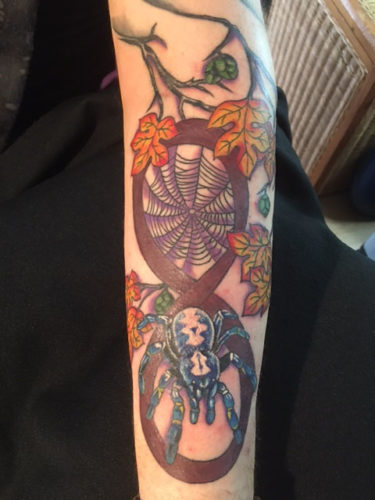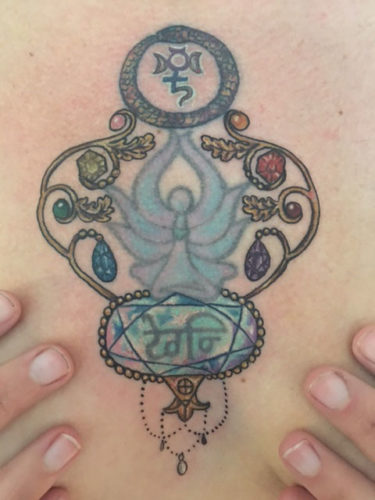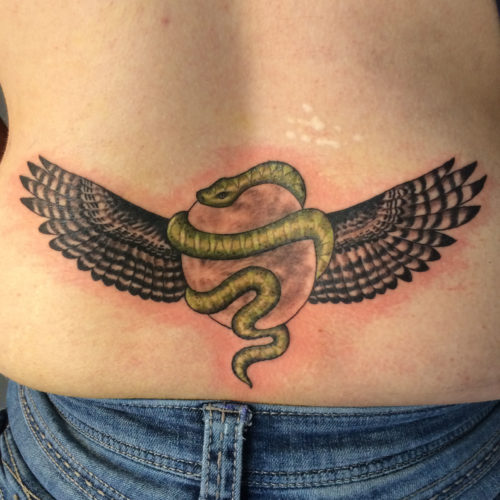
The tattoo has been an important sacred trial for individuals across multiple cultures for generations. The path of pain, identified in Western Witchcraft by Gerald Gardner and other early 20th-century esotericists, has a long history of altering consciousness and manifesting changes in people’s lives. Native cultures around the world have been utilizing the tattoo to mark sacred life passages for centuries, and those of Western heritage have been doing so for almost as long as they have had contact with outside cultures. Whether it is a sacred mark of a warrior initiation, or a mark of military service, sacred ink that tells a tribal person’s life story or a mark of one’s alma mater, tattoos have long represented what is important in the narrative of people’s lives.

[Photo credit: Jen Shakti.]
Jen Shakti, proprietor of the Mermaid’s Tale, is one of those artists. Shakti describes herself as “a modern tattoo shaman” who uses her artistic ability to provide a “medicine gift” to her clients. For her, tattooing is more than a business. It is an initiatory ritual where the magical intention is permanently inscribed into the client. “I use my visionary talent and mythic symbolism with ceremony to create a powerful beneficial shift for my client through the initiation,” she explains. She knows that tattooing is her life’s work.
![Jen Shakti [Courtesy photo]](https://wildhunt.org/wp-content/uploads/2017/03/Tattoo_Jen-334x500.jpg)
Jen Shakti [courtesy photo].
“The perfect clients would come in with projects and experiences that taught me what to do,” she remembers. “Talk about synchronicity!” Through this work, Shakti developed a unique, ceremonial tattoo experience.
“Getting a sacred tattoo is a unique and personalized experience,” says Shakti. First, there is a consultation where she and the client work together to develop both the art and the intention of the ritual. She asks the client what they wish for this tattoo to bring into their lives, and clients sometimes choose to participate in a shamanic healing before they continue with the ceremony. “I listen for clues and details on both the art and the ceremony,” says Shakti, “I ask questions to envision the design and feel what the energetic technique is going to be and the best strategy for working together.”

[Photo credit: Jen Shakti.]
Sacred space is ceremonially closed after the work of the tattoo is complete. With clear energy, the intention has been implanted, and the sacredness is again acknowledged at the end of the working. “It is really sweet and beautiful,” she says.

[Photo credit: Jen Shakti.]

[Photo credit: Jen Shakti.]
Balance, she thinks, can be restored “through initiations and rites of passage.” Shakti believes that “all initiations are an innovation in spirit to engage life at a higher level. I feel that this is what most people are seeking in spiritual practice, and tattoos are a beautiful compliment to that.”
To further that quest for balance, Shakti has begun to offer one- to two day tattoo retreats. They are all-inclusive events. The retreat is a customized experience “to inspire the best version of you.” It includes private accommodations as well as “visits to local sacred sites and a full length healing session.” The tattoo “is the main event.” Shakti says that there is also time for integration, and she offers shamanic techniques to “keep the magic flowing.” Beyond these retreats, Shakti is also willing to train other spiritually-oriented tattoo artists to join in with the sacred tattoo philosophy.
“My vision,” she concludes, “is that as more people get empowered through tattoos consciousness will shift to bring even greater light to the world. I believe that is what I’m here to do at this time.” It is a lofty goal, but Shakti is working toward it session by session, needle by needle, one ceremony at a time.
* * *
The views and opinions expressed by our diverse panel of columnists and guest writers represent the many diverging perspectives held within the global Pagan, Heathen and polytheist communities, but do not necessarily reflect the views of The Wild Hunt Inc. or its management.
The Wild Hunt is not responsible for links to external content.
To join a conversation on this post:
Visit our The Wild Hunt subreddit! Point your favorite browser to https://www.reddit.com/r/The_Wild_Hunt_News/, then click “JOIN”. Make sure to click the bell, too, to be notified of new articles posted to our subreddit.

Great story! I believe in this concept of tattoos as a right of passage. I just wish they didn’t cost so much! I have another one I would like to get but I can not afford it.
I walk a Shamanic path and currently have 3 tattoos. Two are totems as well as honouring paternal and maternal ancestors.
The 90s would have been so much less fun without tribal tattoos and being able to mock and ridicule all the hipster posers about what tribe their tattoo signified that they belonged to..